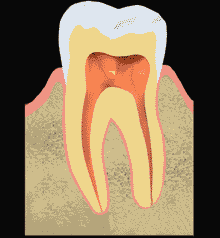As an Endodontic patient, what should I
expect?

We start with a comprehensive examination
to diagnose your dental condition. In
consultation with your restorative dentist,
we will determine if your tooth is a good
candidate for endodontic therapy and explain
your treatment options.
The next step is usually non-surgical
treatment to eliminate the diseased pulp.
The injured pulp is removed and the root
canal system is thoroughly cleansed and
sealed. This therapy usually involves local
anesthesia and may be completed in one or
more visits depending on the treatment
required. Success for this type of treatment
occurs in about 90% of cases. We will inform
you as soon as possible if we determine that
your tooth is not suitable for treatment or
the prognosis changes. Most patients return
to their usual routine after treatment.
Generally, non-surgical treatment is all
that is needed to save teeth with an injured
pulp. Occasionally, this non-surgical
procedure will not be sufficient to allow
healing and we will recommend microsurgery.
Endodontic microsurgery can be used to
locate fractures or hidden canals that do
not appear on x-rays but still cause pain.
Damaged root surfaces and surrounding bone
may also be treated with this procedure. The
most common microsurgical procedure used to
save damaged teeth is an "apicoectomy" or
"root-end resection."
What happens when your root canal
treatment is completed?
You will need to visit your restorative
dentist for a follow-up restoration. A
record of your treatment will be forwarded
to their office.
Your restorative dentist will decide what
type of restoration is needed to protect
your tooth. It is unusual for endodontic
patients to experience complications after
routine endodontic treatment or
microsurgery. If a problem does occur,
however, we are available to respond at all
times.
Top of Page



